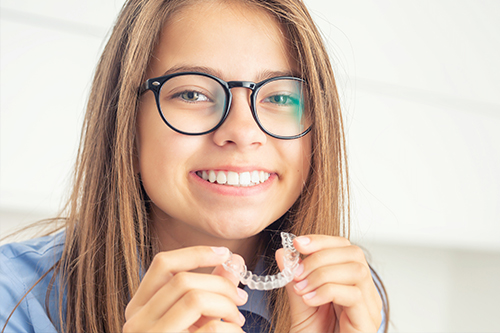Comprehensive initial evaluation
Your clinician begins with a detailed exam and digital scan to assess alignment, bite relationships, and overall oral health. This step ensures treatment is appropriate and safe before moving forward.

Invisalign® offers a modern alternative to traditional braces, using a series of clear, removable aligners to move teeth into healthier, more attractive positions. This approach blends discreet aesthetics with predictable, technology-driven treatment planning so patients can pursue alignment without the look and lifestyle trade-offs of metal brackets and wires.
Invisalign® aligners are made from transparent, medical-grade material that fits snugly over the teeth. Each aligner in the series is slightly different, and every change represents a small, controlled adjustment toward the planned final alignment. Because the trays are clear and low-profile, most people notice them less than traditional orthodontic hardware.
The system is inherently adaptable: attachments, precision cuts, and the sequencing of aligners are all tailored to the movements your clinician determines are necessary. That customization makes it possible to address a range of alignment concerns — from modest crowding to more involved bite issues — while maintaining a focus on comfort and daily convenience.
Another advantage of removable aligners is that oral hygiene routines remain straightforward. Brushing and flossing can continue as normal because the aligners are taken out for short periods during meals and cleaning. That can reduce the risk of staining and makes maintaining gum health simpler during treatment.
Modern aligner therapy relies on detailed digital imaging to create a step-by-step roadmap for tooth movement. A precise intraoral scan captures the exact shape of your teeth and bite; this scan is then used to generate a three-dimensional treatment plan that shows the sequence of aligner changes and the anticipated final position of the teeth.
Because the plan is visual and data-driven, your clinician can preview expected outcomes and make refinements before manufacturing begins. This level of planning allows for better coordination of complex movements and can reduce uncertainty about the pace and endpoint of treatment.
Digital planning also supports communication — you and your provider can review the proposed progression together, discussing how adjustments or additional measures (such as attachments or interproximal reduction) might be used to reach the intended result. The focus remains on a clear, evidence-based strategy tailored to each patient’s unique anatomy and goals.
Treatment with clear aligners typically follows a predictable rhythm: an initial consultation and digital scan, a planning phase where the full sequence is designed, followed by periodic check-ins as you progress through the aligner series. Each set of aligners is generally worn for a set number of days before moving to the next one, with your clinician monitoring progress and making any recommended refinements.
Most patients experience minimal discomfort during transitions between aligners — a brief period of pressure is normal as teeth begin to move into their next position. Any sensitivity is usually short-lived and can be managed with simple over-the-counter remedies and the guidance of your dental team.
Appointments are focused on confirming that movement is tracking as planned and on making any adjustments needed to stay on course. Because the planning is digital and precise, many patients find their visits are efficient and centered on forward momentum rather than prolonged in-office adjustments.
One of the most practical benefits of clear aligners is their removability. You take them out for eating, and you remove them to brush and floss, which preserves normal dietary variety and makes oral hygiene easier during treatment. For many people this flexibility is a meaningful lifestyle advantage over fixed braces.
Compliance is a key factor in achieving the intended result: aligners are most effective when worn for the recommended number of hours each day. Your clinician will provide clear guidance on wear time and best practices to help you stay on track. Using a storage case and setting routine reminders can make adherence simpler.
While the aligners are designed to be discreet, everyday care still matters. Store aligners in their case when not in use, clean them regularly according to your clinician’s instructions, and avoid exposing them to extreme heat. These small habits protect the aligners’ fit and transparency throughout treatment.
Advanced aligner systems combine laboratory data, proprietary manufacturing methods, and ongoing research to refine how teeth are moved. Clinicians use a combination of aligner design features — such as attachments that provide anchor points or staged movements that distribute forces — to manage a variety of tooth movements with greater control.
Because movement is planned digitally, the sequence can be optimized to prioritize certain corrections early or to stage complex adjustments across multiple phases. That phased approach helps maintain biological health while pursuing efficient results.
Retention is an important part of the overall therapy. Once the active phase of alignment is complete, wearing a retainer as directed helps protect the investment of time and maintain the new tooth positions. Your clinician will outline a retention plan tailored to the specifics of your case.
Choosing aligner therapy is a decision that blends clinical judgment, technology, and patient goals. A thorough evaluation defines what can realistically be achieved with clear aligners versus other treatment options, and a clear plan keeps everyone aligned around a shared objective.

Your clinician begins with a detailed exam and digital scan to assess alignment, bite relationships, and overall oral health. This step ensures treatment is appropriate and safe before moving forward.

Using three-dimensional imaging, your provider maps the intended movements and refines the sequence of aligners. This planning phase is where customization ensures the best chance for predictable results.

Aligners are produced to match the scan and treatment plan, with a focus on fit and comfort so that daily wear is as unobtrusive as possible throughout therapy.

From the first fitting to retention, your care team monitors progress, confirms fit, and provides instructions to help you maintain momentum and protect long-term results.
*Invisalign® is a registered trademark of Align Technology, Inc.
At Kennedy Dentistry, we focus on clear communication and individualized care so you understand each step of Invisalign® therapy before treatment begins. If you’re considering aligner-based straightening and want to explore whether it fits your goals, contact us for more information and to schedule a consultation.
There are many options for patients who want to avoid metal braces! The most popular alternative orthodontic treatment is Invisalign®, which are clear plastic aligners designed to straighten teeth. After an examination of your teeth, your dentist will determine which option is best suited to your wants and needs.
According to the Invisalign® website, the cost for treatment is approximately the same as the cost for metal braces. A portion of this cost may be covered by your insurance. Please call us to set up a consultation and discuss potential payment plan options.
The first step is to schedule a consultation with your doctor, so they can devise a treatment plan that is best suited to your individual dental needs. Once approved, you will receive your first set of aligners. Your doctor will then regularly monitor the movement of your teeth and new aligners will be ordered according to the progress made in your treatment plan.
Invisalign® aligners are made of clear, flexible plastic. The company received a patent for this material – SmartTrack® – to be used exclusively for Invisalign treatment purposes. These aligners are FDA approved and nearly invisible!
Your doctor will give you an estimate regarding how long your Invisalign® treatment should take, which will depend on your specific needs. The average length of time for treatment is approximately 12-18 months. However, some patients may see results far sooner. Remember to wear your aligners exactly as instructed by your doctor to obtain the best results.
Your doctor will most likely recommend that you wear retainers following your Invisalign® treatment. This is a precaution that will prevent your teeth from shifting back to their original positioning. It is important to follow your doctor's instructions exactly to ensure long-lasting results.
You must wear your aligners for up to 22 hours daily. You may remove them for eating, drinking and regular oral hygiene.
No. Unlike braces, you may eat whatever you like as long as you remove the aligners before eating. Prior to placing the aligners back on, it is important to brush your teeth and the aligners after you eat.
Like any orthodontic treatment, there is a short adjustment period. The more you speak with the aligners on, the quicker you will adjust.
There will be some pressure and minor discomfort for a day or two after each initial insertion. This is a sign that your teeth are moving sequentially into their final position.
It is recommended that you remove your aligners prior to chewing gum as the gum will stick to the aligners.
We discourage smoking with aligners as the cigarette smoke will tend to discolor them.
Brushing them with toothpaste will keep them fresh and clean.
Regular office visits are every five to six weeks. This will ensure that your Invisalign treatment is progressing as planned.
All orthodontic patients are instructed to wear their retainers at night indefinitely. Sleeping with your retainers in at night will ensure a healthy bite and maintain the new position of your teeth.
Yes, if their teeth, including second molars, have grown in completely.
